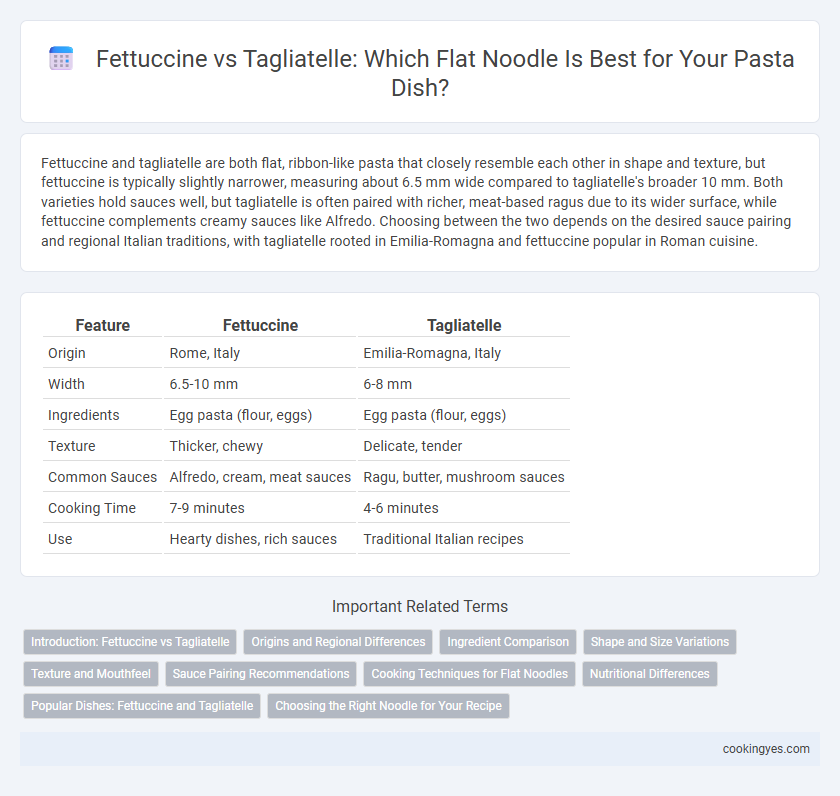Fettuccine and tagliatelle are both flat, ribbon-like pasta that closely resemble each other in shape and texture, but fettuccine is typically slightly narrower, measuring about 6.5 mm wide compared to tagliatelle's broader 10 mm. Both varieties hold sauces well, but tagliatelle is often paired with richer, meat-based ragus due to its wider surface, while fettuccine complements creamy sauces like Alfredo. Choosing between the two depends on the desired sauce pairing and regional Italian traditions, with tagliatelle rooted in Emilia-Romagna and fettuccine popular in Roman cuisine.
Table of Comparison
| Feature | Fettuccine | Tagliatelle |
|---|---|---|
| Origin | Rome, Italy | Emilia-Romagna, Italy |
| Width | 6.5-10 mm | 6-8 mm |
| Ingredients | Egg pasta (flour, eggs) | Egg pasta (flour, eggs) |
| Texture | Thicker, chewy | Delicate, tender |
| Common Sauces | Alfredo, cream, meat sauces | Ragu, butter, mushroom sauces |
| Cooking Time | 7-9 minutes | 4-6 minutes |
| Use | Hearty dishes, rich sauces | Traditional Italian recipes |
Introduction: Fettuccine vs Tagliatelle
Fettuccine and tagliatelle are traditional Italian flat noodles often used interchangeably in recipes, yet they differ slightly in width and regional origin. Fettuccine, measuring about 6.5 mm wide, hails from Rome, while tagliatelle, typically 8 mm wide, originates from the Emilia-Romagna region. Both pasta types are crafted from egg-based dough, making them ideal for rich sauces like Alfredo or Bolognese.
Origins and Regional Differences
Fettuccine originates from Roman cuisine, characterized by its slightly thicker and wider strands, traditionally made with egg and flour. Tagliatelle hails from the Emilia-Romagna and Marche regions in Northern Italy, with a similar shape but a slightly thinner and more delicate texture. Both pastas pair well with rich sauces like Alfredo or Bolognese, reflecting their regional culinary influences.
Ingredient Comparison
Fettuccine and tagliatelle both feature flat, ribbon-like shapes but differ slightly in their ingredient compositions. Traditional fettuccine is made with egg and durum wheat flour, resulting in a firmer texture ideal for creamy sauces like Alfredo. Tagliatelle often uses a similar dough but tends to include a higher proportion of eggs, contributing to a silkier consistency favored in rich meat ragus from Emilia-Romagna.
Shape and Size Variations
Fettuccine and tagliatelle are both flat ribbon-shaped pasta, but fettuccine typically measures about 6.5 to 10 millimeters wide, while tagliatelle is slightly narrower, around 6 to 8 millimeters. The texture and thickness of tagliatelle often allow it to hold richer sauces better, making it ideal for hearty meat ragus. Fettuccine, with a somewhat thicker and sturdier profile, pairs well with creamy Alfredo or butter-based sauces.
Texture and Mouthfeel
Fettuccine features a slightly thicker and sturdier texture compared to tagliatelle, providing a chewier mouthfeel that holds up well to rich, creamy sauces. Tagliatelle offers a smoother, more delicate bite with a tender texture that pairs perfectly with lighter, meat-based ragus. Both flat noodles deliver a satisfying pasta experience but vary in density and softness, influencing how each absorbs and complements different sauce styles.
Sauce Pairing Recommendations
Fettuccine pairs exceptionally well with rich, creamy sauces like Alfredo or carbonara, as its slightly thicker texture holds the sauce effectively. Tagliatelle complements hearty meat ragus, such as Bolognese, absorbing the flavors while maintaining a delicate bite. Both noodles benefit from fresh Parmesan cheese to enhance the overall flavor profile in traditional Italian pasta dishes.
Cooking Techniques for Flat Noodles
Fettuccine and tagliatelle, both traditional Italian flat noodles, differ primarily in thickness and width, affecting their cooking techniques; fettuccine is slightly thicker, requiring a longer boiling time of around 8-10 minutes, while tagliatelle cooks faster, typically in 3-5 minutes due to its thinner profile. Optimal cooking for both involves boiling in salted water until al dente, then draining and tossing immediately with sauce to prevent sticking and maintain texture. Using fresh pasta alters cooking time significantly, often reducing it to 1-3 minutes and enhancing flavor absorption during the finishing step.
Nutritional Differences
Fettuccine and tagliatelle share a similar calorie count and macronutrient profile, primarily composed of carbohydrates and moderate protein due to their wheat base. Whole wheat versions of either pasta offer higher fiber content and additional micronutrients such as B vitamins and iron compared to traditional refined flour varieties. Both flat noodles vary minimally in glycemic index, making them comparable choices for balanced energy release in meals.
Popular Dishes: Fettuccine and Tagliatelle
Fettuccine, a flat noodle originating from Rome, is prominently featured in popular dishes such as Fettuccine Alfredo and Fettuccine Carbonara, known for their rich, creamy sauces. Tagliatelle, hailing from Emilia-Romagna, pairs traditionally with hearty ragu alla Bolognese, showcasing its perfect texture for absorbing robust meat sauces. Both noodles share a similar width but differ slightly in thickness, influencing their ideal sauce pairings in Italian cuisine.
Choosing the Right Noodle for Your Recipe
Fettuccine and tagliatelle are both flat, ribbon-like noodles with subtle regional differences that affect texture and flavor absorption in dishes. Fettuccine, typically made with egg and flour, is slightly thicker and better suited for creamy sauces like Alfredo, while tagliatelle's thinner, more delicate structure pairs well with lighter, meat-based sauces such as Bolognese. Selecting the right noodle depends on the sauce's consistency and the desired mouthfeel, ensuring a balanced and harmonious pasta dish.
Fettuccine vs tagliatelle for flat noodles Infographic

 cookingyes.com
cookingyes.com